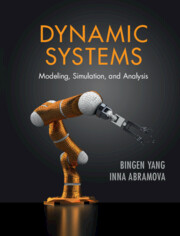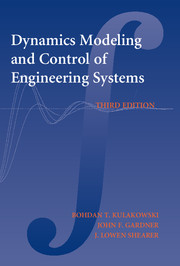Dynamic Systems
Presenting students with a comprehensive and efficient approach to the modelling, simulation, and analysis of dynamic systems, this textbook addresses mechanical, electrical, thermal and fluid systems, feedback control systems, and their combinations. It features a robust introduction to fundamental mathematical prerequisites, suitable for students from a range of backgrounds; clearly established three-key procedures – fundamental principles, basic elements, and ways of analysis – for students to build on in confidence as they explore new topics; over 300 end-of-chapter problems, with solutions available for instructors, to solidify a hands-on understanding; and clear and uncomplicated examples using MATLAB®/Simulink® and Mathematica®, to introduce students to computational approaches. With a capstone chapter focused on the application of these techniques to real-world engineering problems, this is an ideal resource for a single-semester course in dynamic systems for students in mechanical, aerospace and civil engineering.
- Introduces a three-key procedure for modelling dynamic systems (fundamental principles, basic elements, and ways of analysis), building student confidence as they methodically work through fundamental topics
- Reviews the relevant mathematics so that students from different mathematical backgrounds can master concepts with ease
- Integrates modelling, simulation and analysis of dynamic systems in an entire chapter dedicated to application problems, providing students with a comprehensive and hands-on review of the theories and methods covered in the book
- Illustrates examples with Matlab®/Simulink® and Mathematica®, so that students can apply the theory to application into computational software
- Clear and concise mathematical treatments of physical problems mean students don't need to wade through complex derivations
Reviews & endorsements
'A good teaching reference, particularly for new faculty in this area. Certainly, the book is also good for students as it contains lots of sample codes in MATLAB and Mathematica.' Jian-qiao Sun, University of California, Merced
'An excellent fit for junior undergraduates in engineering to learn about mathematical modeling of several physical systems, and further solving the models to predict their behaviors. The relationship between inputs, system state, and outputs of a system are emphasized throughout the book. Additionally, the mathematical models are also represented using block diagrams that can then be simulated. The layout of the book strongly supports learning of fundamental principles and elements of modeling at the beginning, followed by their adaptation to both simple and complex real-world dynamic systems in other chapters.' Rajesh Ganesan, George Mason University
'Adopting a holistic approach, this book addresses the modeling, simulation, and analysis of dynamic systems at the undergraduate level. It provides comprehensive coverage of fundamental concepts, with carefully selected applications from different fields of engineering. The exposition is methodical and the accompanying illustrations are extensive, a combination that makes the book remarkably easy and enjoyable to read.' Fai Ma, University of California, Berkeley
'An excellent book on the dynamics of multi-domain systems. It is thorough and comprehensive, with a good balance of physical interpretation, mathematical formulation, practical applications, and numerical simulations.' Steve Shen, University of Washington
'Provides an excellent introduction to the subject and equips students with in-depth understanding of the fundamental principles of modeling of dynamic systems. The book contains a broad range of examples, helping students to build a strong foundation in this subject. The sequence of chapters, beginning with basics and ending with real-world applications, is well planned.' Chi-An Tan, Wayne State University
Product details
November 2022Hardback
9781107179790
800 pages
253 × 195 × 39 mm
1.841kg
Available
Table of Contents
- 1. Introduction
- 2. Fundamentals of mathematics
- 3. Mechanical systems
- 4. Electrical systems
- 5. Thermal and fluid systems
- 6. Combined systems and system modeling techniques
- 7. System response analysis
- 8. Introduction to feedback control systems
- 9. Application problems
- Appendix A. Units
- Appendix B. MATLAB/Simulink basics
- Appendix C. Wolfram Mathematica basics
- Index.






